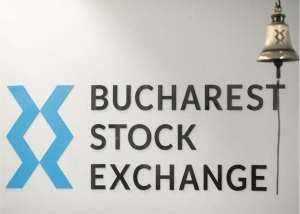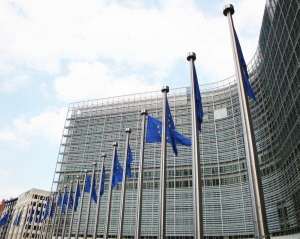Bursa din Budapesta (BÉT) este structurată, în esenţă, în două mari segmente: piaţa "cash" (spot sau la vedere) şi piaţa de derivate (la termen).
În piaţa "cash", unde ciclul de decontare este de două zile de la încheierea tranzacţiei (T+2), sunt listate acţiuni, mai multe tipuri de obligaţiuni (guvernamentale, corporative, ipotecare), fonduri mutuale, certificate sau ETF-uri (unul ce urmăreşte evoluţia indicelui BUX şi câteva străine). Acţiunile sunt de departe cele mai tranzacţionate instrumente financiare, anul trecut 95,4% din valoarea totală a schimburilor realizate pe acest segment de piaţă fiind cu acţiuni, în timp ce transferurile cu certificate şi warrant-uri au dat 3,4% din suma totală.
Există trei segmente de piaţă pentru acţiuni ale companiilor locale (Principală, Standard şi T) şi un segment (BETa), prin care investitorii pot tranzacţiona, în forinţi, acţiuni străine.
• Patru emitenţi dau aproape 90% din capitalizarea bursieră a companiilor listate la Budapesta
În fiecare din primele trei luni ale acestui an, capitalizarea companiilor ungare a fost de circa 23,9 miliarde de euro, conform datelor publicate de BÉT, valoare similară cu cea indicată de Federaţia Europeană a Valorilor Mobiliare (FESE). Pentru Bursa de Valori Bucureşti (BVB), FESE arată o capitalizare de 22,23 miliarde de euro, în februarie, echivalentul valorii de piaţă a companiilor româneşti (fără Erste Group Bank), conform raportului operatorului pieţei noastre de capital. Pentru luna trecută, BVB a raportat o capitalizare bursieră a companiilor româneşti de 23,9 miliarde euro.
Instituţia financiară OTP Bank, compania de petrol şi gaze MOL, şi producătorul de medicamente Gedeon Richter, au dat luna trecută aproximativ 83% din capitalizarea acţiunilor listate la Budapesta, iar împreună cu furnizorul de servicii de telecomunicaţii Magyar Telekom, au reprezentat 88% din valoarea de piaţă a acţiunilor ungare.
Practic, la finele lunii martie, capitalizarea OTP era de 10,16 miliarde de euro (42,6% din total), cea a MOL se ridica la aproape 5,04 miliarde de euro (21,1%), pentru Richter valoarea de piaţă era de 4,66 miliarde euro (19,5%), iar pentru Magyar Telekom capitalizarea se situa la 1,16 miliarde euro (4,9%), conform datelor bursei din Budapesta.
• Tranzacţii zilnice cu acţiuni de peste trei ori mai mari ca la BVB
În ceea ce priveşte valoarea tranzacţiilor cu acţiuni ungare, în martie, rulajul mediu zilnic a fost de 32,2 milioane de euro, în februarie de 30,7 milioane euro, iar pentru întregul an 2020, valoarea medie zilnică a schimburilor cu acţiuni s-a ridicat la 38,3 milioane de euro.
Comparativ, anul trecut la BVB, valoarea medie zilnică a tranzacţiilor cu acţiuni listate pe Segmentul Principal a fost de 10,14 milioane de euro, adică de aproape patru ori mai mică decât cea de la Budapesta.
Tranzacţiile cu acţiunile OTP, MOL şi Gedeon Richter au dat, în martie, peste 93% din totalul schimburilor realizate la bursa din Budapesta. Practic, transferurile cu titlurile OTP au asigurat 52,7% din valoarea totală tranzacţionată, cele cu acţiunile MOL 21%, iar cele cu titlurile Richter 19,6%. Împreună cu tranzacţiile realizate cu titlurile Magyar Telekom, cele patru companii au furnizat 95,5% din rulajul lunii martie al acestui segment al BÉT.
• Rulaj mediu zilnic de 17 milioane de euro pentru acţiunile OTP Bank
În luna martie, tranzacţiile medii zilnice cu acţiunile OTP Bank au fost de 17 milioane de euro, de peste două ori mai mult decât valoarea tranzacţiilor întregii Pieţe Reglementate de la BVB, de 7,81 milioane de euro.
OTP Bank este cea mai mare bancă universală din Ungaria şi un furnizor important de servicii financiare în Europa Centrală şi de Est, fiind prezentă în nouă ţări. Acţiunile sale au fost listate în 1995 şi, în prezent, dau aproape în fiecare lună cel puţin jumătate din valoarea totală a tranzacţiilor cu acţiuni de la Bursa din Ungaria, după cum reiese din datele studiate de noi.
La finele lunii februarie, instituţia de credit avea un free-float de 74,05%, conform informaţiilor disponibile pe site-ul BÉT. În rest, cel mai mare acţionar era compania MOL, ce deţinea 8,57% din titlurile OTP, fiind urmat de Kafijat Zrt. (trust deţinut de miliardarul rus Megdet Rahimkulov), cu 7,08% din acţiunile băncii.
La finele anului trecut, 71,75% din acţiunile OTP erau deţinute de investitori străini, în timp ce investitorii maghiari (excluzând statul, angajaţii şi acţiunile de trezorerie) aveau 25,72% din instituţia de credit, conform informaţiilor publicate de bancă.
• O cincime din MOL este deţinută de două universităţi
MOL Hungarian Oil and Gas este una dintre cele mai importante companii din industria petrolului şi gazelor din Europa Centrală, cu activităţi de explorare sau producţie în 15 ţări. Acţiunile companiei au fost listate în 1995 şi, în medie, dau în jur de 20% din valoarea tranzacţiilor acestui segment de piaţă.
Free-float-ul companiei era de 54,05% în februarie, în timp ce Maecenas Universitatis Corvini Fund şi Tihanyi Alapítvany aveau fiecare câte 10% din MOL, conform datelor bursei ungare.
Maecenas Universitatis Corvini Fund este o fundaţie a Universităţii Corvinus din Budapesta, care a primit acţiunile de la Guvern, în vederea finanţării universităţii din dividende. Transferul, care a inclus şi acţiuni Richter, s-a realizat la începutul lui 2019, iar universitatea nu are voie să vândă participaţiile la companii, se arată într-un articol din Reuters. Fundaţia Tihanyi este întemeietoarea Colegiului Mathias Corvinus, instituţie privată de învăţământ interdisciplinar ce a început să funcţioneze în 1996. Tihanyi a primit acţiunile în 2020 de la Compania Naţională de Administrare a Activelor din Ungaria, pentru a susţine activitatea colegiului.
Alţi acţionari importanţi ai MOL sunt Oman Oil (Budapest) şi OTP Bank, în timp ce Statul mai deţine indirect 5,24% din compania petrolieră. În rest, 27,5% din acţiunile companiei sunt deţinute de investitori străini (în principali instituţionali), 10% de investitori instituţionali maghiari şi 6,9% de investitori de retail locali, conform datelor publicate de companie.
• Două treimi din Gedeon Richter aparţin investitorilor străini
Gedeon Richter este cel mai mare producător de medicamente din Ungaria şi unul dintre cei mai mari din Europa Centrală şi de Est, produsele sale găsindu-se în aproape 100 de ţări. Acţiunile companiei au fost listate în 1994 şi, în general, asigură cam 20% din lichiditatea segmentului de acţiuni al bursei din Budapesta.
Free-float-ul producătorului de medicamente este de 69,68%, conform informaţiilor prezentate de BÉT, iar Maecenas Universitatis Corvini Fund şi Tihanyi Alapítvany au fiecare câte 10%. Statul, prin Compania Naţională de Administrare a Activelor din Ungaria are 5,25% din producătorul de medicamente, în timp ce americanii de la Fidelity Investments deţin 5,07% din Gedeon Richter.
În ansamblu, la finele anului trecut, 33,22% din companie era deţinută de investitori locali (din care 3,38% retail), iar 66,41% erau investitori străini, conform ultimului raport anual al companiei.
• Piaţa Xtend - Sistemul Multilateral de Tranzacţionare al bursei ungare
Lansată în 2017, piaţa Xtend este platforma Multilaterală de Tranzacţionare a bursei din Budapesta creată pentru a susţine planurile de creştere ale companiilor mici şi medii.
În prezent, pe acest segment al pieţei sunt listate acţiunile a cinci emitenţi, distribuitorul de utilaje pentru construcţii şi agricultură DM-KER având cea mai mare capitalizare, de circa 23,8 milioane de euro, pe baza preţului acţiunii de la finele săptămânii trecute. Rulajele sunt modeste, existând frecvent zile fără tranzacţii.
Pe lângă piaţa Xtend, mai există piaţa Xbond, adică Sistemul Multilateral pentru tranzacţionarea obligaţiunilor corporative, în prezent fiind listate peste 50 de emisiuni, tranzacţiile fiind extrem de sporadice.
Atât ca număr de emitenţi, dar mai ales ca activitate de tranzacţionare, acest segment al bursei din Budapesta este cu mult sub cel al bursei din Bucureşti unde, începând cu a doua parte a anului trecut am avut un val de listări, iar tranzacţiile sunt tot mai mari.
• Tranzacţii medii zilnice de 30,2 milioane euro, cu instrumente derivate
În piaţa de derivate pot fi tranzacţionate contracte futures sau opţiuni cu active suport perechi valutare, acţiuni şi indici.
Luna trecută, tranzacţiile totale cu instrumente financiare derivate au fost în valoare de 665,4 milioane de euro (echivalentul unei medii zilnice de 30,2 euro), conform datelor publicate de BÉT. Din această sumă, 557,7 milioane de euro (25,4 milioane euro zilnic), echivalentul a aproape 84% din total, au fost tranzacţiile contractelor futures valutare, cele mai mari fiind realizate cu cele ale perechilor EUR/HUF şi USD/HUF, în forinţi. Schimburile cu futures pe acţiuni (în mare parte OTP, MOL şi Richter) au fost de 57,5 milioane de euro (2,6 milioane euro zilnic), echivalentul a 8,64% din total. Valoarea tranzacţiilor contractelor pe indici (doar BUX) a fost de 48,9 milioane de euro (2,2 milioane euro zilnic), reprezentând 7,34% din total.
Anul trecut, tranzacţiile totale realizate cu instrumente derivate la bursa din Budapesta s-au ridicat la 6.857,4 milioane de euro, 77,78% provenind din tranzacţii cu futures pe valute, 11,48% din cele cu futures pe indici, 10,5% din transferuri cu futures pe acţiuni, în timp ce tranzacţiile cu opţiuni valutare au avut o pondere relativă redusă.
Bursa din Budapesta mai are şi o piaţă de cereale (spot şi derivate), tranzacţiile fiind însă foarte reduse.
--------------------------------------------------------------------------------------------------
The Budapest Stock Exchange - structure, capitalization and turnover
• Trading in shares of OTP Bank, MOL and Gedeon Richter generated 93% of the total turnover of the Hungarian stock exchange in March
• Contracts with currency pairs as their underlying assets generate about 80% of derivative trades
Broadly speaking, the Budapest Stock Exchange (BÉT) has two major sections: the "cash" (spot) market and the derivatives (term) market.
On the "cash" market, where the settlement cycle is two days from the conclusion of the transaction (T + 2), are listed stocks, several types of bonds (government, corporate, mortgage), mutual funds, certificates or ETFs (one that tracks the evolution of the BUX index and a few foreign ones). Shares are by far the most traded financial instruments, (95.4% of the total turnover last year). Trading in certificates and warrants accounted for 3.4% of the total amount.
There are three market segments for shares of local companies (Principal, Standard and T) and one segment (BETa), through which investors can trade foreign shares in forints.
• Four issuers account for almost 90% of the market capitalization of the companies listed on the Budapest Stock Exchange
In each of the first three months of this year, the capitalization of Hungarian companies was about 23.9 billion euros, according to data published by BÉT, an amount similar to that indicated by the European Federation of Securities (FESE). For the Bucharest Stock Exchange (BVB), FESE shows a capitalization of 22.23 billion euros, in February, the equivalent of the market value of Romanian companies (without Erste Bank Group), according to the report of the Romanian stock market operator. For March, the BSE reported a market capitalization of the Romanian companies of 23.9 billion euros.
Financial institution OTP Bank, oil and gas company MOL, and drug manufacturer Gedeon Richter, last month accounted for about 83% of the capitalization of the shares listed in Budapest, and together with telecommunications service provider Magyar Telekom, they represented 88% of the value Hungarian stock market.
At the end of March, OTP's capitalization was 10.16 billion euros (42.6% of the total), whereas for MOL it amounted to almost 5.04 billion euros (21.1%). For Richter the market valuation was 4.66 billion euros (19.5%), and for Magyar Telekom the capitalization was 1.16 billion euros (4.9%), according to data from the Budapest Stock Exchange.
• Daily stock trading turnover is over three times higher than on the BSE
For comparison, last year on the BSE, the median daily value of trades in shares listed on the Main tier was 10.14 million euros, i.e. almost four times lower than in Budapest.
Trading in OTP, MOL and Gedeon Richter shares accounted for over 93% of the total trades made on the Budapest stock exchange in March. Trades in OTP shares provided 52.7% of the total turnover, whereas MOL shares stood for 21%, and Richter shares represented 19.6%.
Together with trades in Magyar Telekom stock, the four companies provided 95.5% of the March turnover of their BÉT segment.
Regarding the value of trading in Hungarian stocks, in March, the average daily turnover was 32.2 million euros, up from 30.7 million euros in February, and for the whole year 2020, the average daily turnover in stocks rose to 38.3 million euros.
For comparison, last year on the BSE, the average daily value of trades in shares listed on the main tier was 10.14 million euros, i.e. almost four times lower than in Budapest.
• Average daily turnover of 17 million euros for OTP Bank shares
In March, the median daily turnover for OTP Bank shares amounted to 17 million Euros, more than twice the entire turnover of the entire Regular Market of the BSE (7.81 million Euros).
OTP Bank is the largest universal bank in Hungary and a major provider of financial services in Central and Eastern Europe, present in nine countries. Its shares were listed in 1995 and currently account for almost half of the total turnover on the Hungarian Stock Exchange almost every month, according to our data.
At the end of February, the lender institution had a free-float of 74.05%, according to information available on the BÉT website. The largest shareholder is MOL, which held 8.57% of the shares of OTP, followed by Kafijat Zrt. (a trust owned by Russian billionaire Megdet Rahimkulov), who owns 7.08% of the bank's shares.
At the end of last year, 71.75% of OTP shares were owned by foreign investors, while Hungarians (excluding the state, the employees and the shares of the treasury) owned 25.72% of the lender, according to data published by the bank.
• One fifth of MOL is owned by two universities
MOL Hungarian Oil and Gas is one of the leading oil and gas companies in Central Europe, with exploration or production activities in 15 countries. The company's shares were listed in 1995 and, on average, account for about 20% of the market segment it is in.
The company's free-float was 54.05% in February, while Maecenas Universitatis Corvini Fund and Tihanyi Alapítvany each held 10% of MOL, according to data from the Hungarian stock exchange.
Maecenas Universitatis Corvini Fund is a foundation of the Corvinus University of Budapest, which received the shares from the government, to allow the university to be funded using the dividends. The transfer, which also included Richter stock, was made in the beginning of 2019, and the university is not allowed to sell those holdings, Reuters reports. The Tihanyi foundation is the founder of the Mathias Corvinus College, a private multidisciplinary learning institution which began operating in 1996. Tihanyi got the shares in 2020 from the National Asset Management Company of Hungary, to support the activity of the college.
Other important shareholders of MOL are Oman Oil (Budapest) and OTP Bank, while the State still indirectly holds 5.24% of the oil company. 27.5% of the company's shares are owned by foreign investors (mainly institutionals), 10% by Hungarian institutional investors and 6.9% local retail investors, according to the data published by the company.
• Two thirds of Gedeon Richter owned by foreign investors
Gedeon Richter is the the largest drug manufacturer in Hungary and one of the largest in Central and Eastern Europe. Its products can be found in almost 100 countries. The company's shares were listed in 1994 and generally provide about 20% of the liquidity of the stock segment of the Budapest Stock Exchange.
The drug manufacturer's free-float is 69.68%, according to information provided by BÉT, and Maecenas Universitatis Corvini Fund and Tihanyi Alapítvany each own 10%. The state, through the Hungarian National Asset Management Company, holds 5.25% of the drug manufacturer, while American fund Fidelity Investments holds 5.07%.
Overall, at the end of last year, 33.22% of the company was owned by local investors (of which 3.38% retail), and 66.41% by foreign investors, according to the company's latest annual report.
• The Xtend market - the multilateral trading system of the Hungarian Exchange
Launched in 2017, Xtend Market is the Budapest Stock Exchange Multilateral Trading Platform created to support the growth plans of small and medium-sized companies.
Currently the shares of five issuers are listed on this market segment. Construction and agricultural equipment distributor DM-KER has the largest capitalization, of about 23.8 million euros, based on the stock price from the end of last week. Turnover is modest, with days where there are no trades being rather frequent.
In addition to the Xtend market, there is also the Xbond market, i.e. the Multilateral System for trading corporate bonds, which currently has over 50 issues listed, with extremely sporadic trading.
Both in terms of number of issuers, but especially in terms of trading activity, this segment of the Budapest stock exchange is far below that of its Bucharest peer, where, starting with the second half of last year, we had a wave of listings, and turnover has been constantly rising.
• 30.2 million Euros in derivative trades
The derivatives market allows trading of futures or options contracts with currency pairs, stocks and indexes as their underlying assets.
Last month, total transactions with derivative financial instruments amounted to 665.4 million euros (equivalent to a daily average of 30.2 euros), according to data published by BÉT. Of that amount, 557.7 million euros (25.4 million euros per day), the equivalent of almost 84% of the total, was the result of trading in forex futures, with the largest being the EUR / HUF and USD / HUF pairs, in forints. Stock futures trades (mostly OTP, MOL and Richter) amounted to 57.5 million euros (2.6 million euros daily), equivalent to 8.64% of the total. The value of index contract trades (BUX only) was 48.9 million euros (2.2 million euros per day), representing 7.34% of the total.
Last year, total derivatives trades on the Budapest Stock Exchange amounted to 6,857.4 million euros, of which 77.78% foreign exchange futures trades, 11.48% from index futures, 10.5% of stock futures transfers, while trading in foreign exchange options had a relatively small share.
The Budapest Stock Exchange also has a grain market (spot and derivatives), but trading is low.


































































